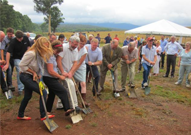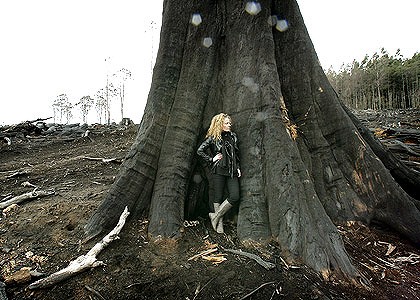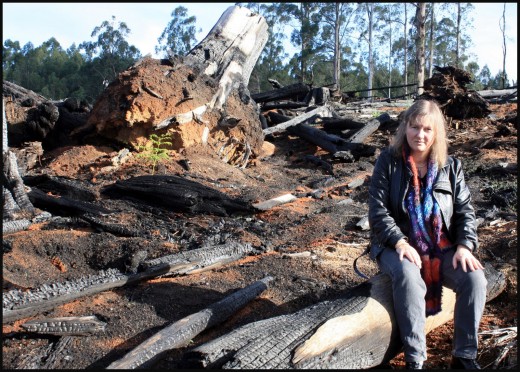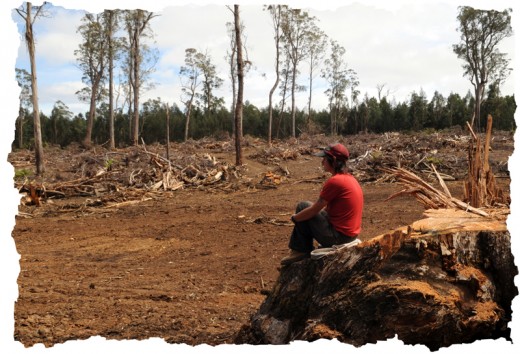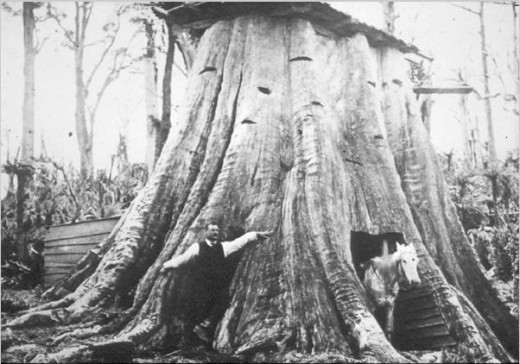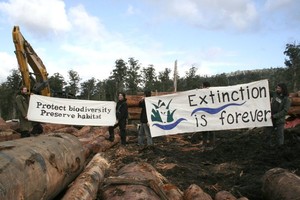VicForests’ ecological genocide
Friday, August 19th, 2011.
 VicForests’ neo-colonial practice of logging old growth East Gippsland forests, justifies such culling by claiming compliance with Australia’s wood production Standard AS 4708-2007. But this standard is Mein Kampf for ecological genocide of East Gippsland Forests.
VicForests’ neo-colonial practice of logging old growth East Gippsland forests, justifies such culling by claiming compliance with Australia’s wood production Standard AS 4708-2007. But this standard is Mein Kampf for ecological genocide of East Gippsland Forests.
Have a read: http://www.forestrystandard.org.au/files/Standards/4708.pdf [Read the Standard]
Under this official Australian Standard that sees only the wood for the trees, it includes two criteria that serve to deliver propaganda spin respect for forest ecology. One must recognise these criteria accompanying Criterion 4—Forest management shall maintain the productive capacity of forests. Need I say more?
Forestry Propaganda Criterion #3 for instance, requires forest management to ‘protect and maintain the biological diversity of forests’. Wonderful wholesome, noble and holistic rumblings about this one – but gullibles wake! VicForests <em>Mein Kampf</em> hides the ‘ chainsaw-speak‘ in the detail:
* ‘Small-scale clearing is permitted up to a limit of 40 hectares on a single forest management unit’. ‘Conservation of threatened (including vulnerable, rare or endangered) species and ecological communities requires the forest manager to minimise adverse impacts by ensuring he/she takes into account of known information and relevant specialist advice‘. (Makes Fiji look like a democracy!)
Forestry Propaganda Criterion 5 requires forest management to maintain forest ecosystem health and vitality, yet is so vague as to allow forest ‘practices’ only to ensure that damage stays “within tolerable levels”. Does this mean one tree per hectare can be left standing or may be two?
.
Then there’s Clause 4.5.3:
‘Forest managers managing native forests shall use fire and other disturbance regimes to maintain and enhance forest ecosystem health where appropriate to the forest type or scale.’ [p.25]
.
…that is, burn and disturb native forests at will, because we argue that doing so enhances forest ecosystem health. Whoops! The wind picked up and the forest is gone; still we complied with AS 4708-2007!
Such contemptible logic would argue that a bushfire raging through a town can to it good, because eventually the town is rebuilt and the people eventually return, look at Narbethong!
.
.
The Ferguson Tree – lest we forget
.
“The tallest tree ever properly measured was a Eucalyptus tree and was 436 feet tall. It was measured by William Ferguson on the 21st of February in 1872. Alarmingly the crown was broken off when the tree was still 1 meter thick, leading to claims that it once was up to five-hundred feet tall in one point in its lifetime.”
The length was a staggering (if true) 133 metres (436 feet) with its crown (the tree’s top) broken off!! The stump’s diameter five feet off the ground was 5.5m (18 feet) and at its broken top its diameter was still 1 metre. It is estimated that had this tree actually still been intact it would have approached 152m (500 feet) in height. The surveyor also noted numerous fallen trees in the same area over 106m (350feet) in height.
It would have been a Mountain Ash or Eucalyptus regnans. Sorry, no photo available. The legend remains only in text.
[Source: ^http://jtpredwoods12345.blogspot.com/]
.
.
‘VicForests accused of felling old-growth mountain ash’
.
[Source: Adam Morton, 20100629, The Age newspaper, ^http://www.theage.com.au/victoria/vicforests-accused-of-felling-oldgrowth-mountain-ash-20100628-zf5o.html] .
‘The Victorian government’s forestry arm will face a legal challenge over claims it illegally logged old-growth forest and increased the risk to a threatened species.
Environmental groups accuse VicForests of felling dozens of pre-1900 ash eucalypts, breaching the Central Highlands Forest Management Plan. An impending legal case will also claim the timber agency failed to protect habitats necessary for the survival of Victoria’s threatened faunal emblem, Leadbeater’s possum.
Ecologist Jacques Cop, from consultants Acacia Environmental Group, said a survey of just one coupe near Toolangi found 31 pre-1900 ash eucalypts had been logged. Five stumps were more three metres across.
”These are trees that are 200 or 300 years old,” he said.
Mr Cop said the area should also have been protected as a Leadbeater’s possum habitat as it met the threshold of having at least 12 hollowed trees within three hectares. He said neither the state Department of Sustainability and Environment nor VicForests carried out ground surveys to check if ecological requirements were being met. Sarah Rees, president of local group My Environment, said the situation was an emergency.
’31 pre-1900 ash eucalypts had been logged’
.
“If this doesn’t stop we’re going to lose the last viable habitat for a range of different species, but Leadbeater’s possum carries the strongest case for legal protection“, she said.
The state government said it took the allegations “extremely seriously“.
Spokesman Michael Sinclair said VicForests would investigate the alleged breaches and report to the Department of Sustainability and Environment. VicForests spokesman David Walsh said the agency carried out detail planning before harvesting to ensure it acted within the law and had offered to meet local residents to better understand their concerns.
“No old-growth forest is harvested by VicForests in Victoria’s central highlands region”, he said.
The legal case, being prepared on behalf of a group called the Flora and Fauna Research Collective, comes amid community concern about the scale of logging in the central highlands after the Black Saturday bushfires.
The Wilderness Society said that evidence supporting the latest claims showed illegal logging of native forests was rife under the state government’s watch.
A separate allegation of illegal logging at Brown Mountain, in east Gippsland, is the subject of a pending Supreme Court judgment.
“Premier Brumby must act now to end VicForests’ woodchip rampage in Victoria’s magnificent native forests“, said Wilderness Society spokesman Luke Chamberlain.
Sarah Rees at the base of an ancient mountain ash spared the chainsaw but killed during a clean-up fire near Toolangi. She says the present situation is an emergency. Photo: John Woudstra.
.
 VicForests motto reads: “Victorian Timber: beautiful, natural, functional”
VicForests motto reads: “Victorian Timber: beautiful, natural, functional”
.
..in lay terms, this means kill beautiful natural specimens – they make the finest woodchips for reliable REFLEX office paper.
.
.
VICFORESTS: “VicForests employs over 140 staff across 10 Victorian sites located in Melbourne, Healesville and regional areas of Central Highlands and East Gippsland.
We have a variety of exciting career opportunities available – our Foresters specialise in tactical and operational planning, roading, harvesting and contract management, silviculture and native forest regeneration.
Other career paths include customer management, resource and business analysts, safety and risk, operational audit, forest scientists and product delivery.”
VICFORESTS: “We also employ staff in non-forestry roles including IT, HR, communications, finance, administration and customer service. A significant proportion of our staff and contractors are also involved with fire-fighting efforts each year.
VicForests is focused on investing in its employees through training, development, and providing career opportunities.”
VICFORESTS: “We look for dynamic people who have a strong desire to be part of an organisation that strives to achieve success through implementing excellent and innovative business and timber industry practices for our customers and stakeholders.
Contributing to the timber industry is something that VicForests and its staff are proud of.”
.
[Source: ^http://vicforests.logic1.com.au/employment.htm, accessed 20110819]
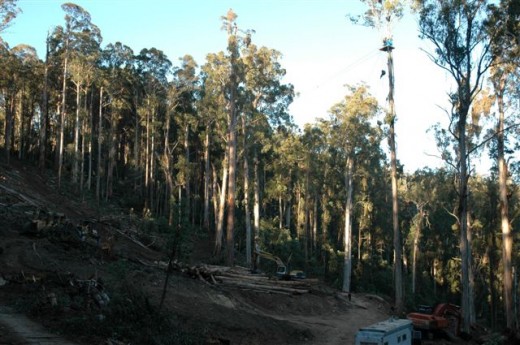 Vicforests’ coup at Stoney Creek
East Gippsland 2009
Vicforests’ coup at Stoney Creek
East Gippsland 2009
.
.
‘VicForests’ 2009 Annual Report reveals $5.1 million loss’
.
‘VicForests’ 2009 Annual Report has once again revealed that the logging agency continues to waste taxpayer millions of dollars sending our forests to the woodchip mills. The report shows that VicForests has posted a loss this year of $5.1 million. This is on top of last year posting a tiny profit after receiving a $5 million lifeline from government, and a loss the previous year.
 Woodchip train makes its way to Midways, Geelong (2009) for as little as $2.50 per tonne.
Photo: Wilderness Society Collection
Woodchip train makes its way to Midways, Geelong (2009) for as little as $2.50 per tonne.
Photo: Wilderness Society Collection
.
‘Whilst VicForests squanders Victorian taxpayer’s hard earned money, woodchipping and paper companies continue to post handsome profits. Whilst we don’t yet know how much they will make for 2009, South East Fibre Exports, a wholly owned subsidiary of Japanese paper giant, Nippon Paper, last year made over $10 million profit. They woodchipped approximately half a million tonnes of Victoria’s native forests, and this year paid as little as $2.50 per tonne for them.
Another giant company, Australian Paper, which makes Reflex papers, is VicForests’ largest single customer and was recently purchased for around $700 million by Nippon Paper. The $5.1 million loss is on top of an extra $1.3 million handout for bushfire recovery and does not include the massive $29 million royalty that it has failed to hand over to the state government who, along with the Victorian public, own these forests.’
.
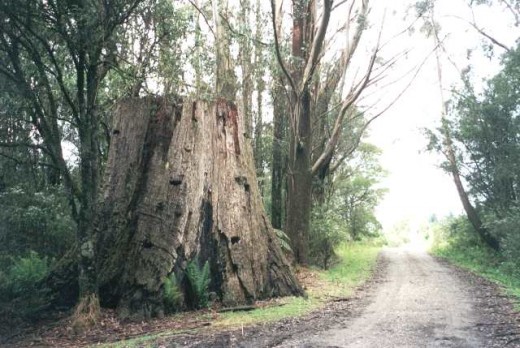 A tombstone of the once impenetrable forest.
A Mountain Ash stump alongside an old forestry track in Balnook, Gippsland.
Note the notches cut in the trunk for standing planks to cut the tree down by axe!
A tombstone of the once impenetrable forest.
A Mountain Ash stump alongside an old forestry track in Balnook, Gippsland.
Note the notches cut in the trunk for standing planks to cut the tree down by axe!
.
.
Reflex Office Paper
‘Paperlinx’s giant Maryvale mill located in Victoria’s Central Highlands is the largest pulp and paper making complex in Australia, consuming 475,000 cubic metres of eucalyptus forest per annum (RFA, 1998).
‘In July 2006, the Maryvale Mill received Forest Stewardship Council (FSC) Chain of Custody Certification for A4 Reflex products manufactured on its Number 3 and Number 5 Paper Machines. Paperlinx has been proudly promoting its environmental credentials ever since (as well as before).
Paperlinx is Australia’s only office paper producer. Its flagship product REFLEX copypaper is 100 per cent virgin native forest. Woodchips to make the paper are sourced from areas including rainforest, old growth forest, endangered species habitat and Melbourne’s largest water source, the Thompson Dam catchment area. Woodchips are also sourced from the Strzelecki Rainforest Reserve, an area that was promised protection by the state government due to its high conservation value.
These areas can be visited and viewed first hand, or determined by satelite image maps which show different forest types (such as rainforest as compared to woodlands) and where logging is occuring. The fact that Paperlinx gained FSC accreditation has raised concerns amoung environment groups who have been campaigning for the protection of these areas for over a decade.
Reflex Recycled Paper
Paperlinx has recently released a brand of paper wrapped in green packaging labelled Recycled. Fifty percent of REFLEX Recycled paper is made from pre-consumer waste (printers’ offcuts), but no genuine post-consumer (eg kerbside collected) recycled papers. The other fifty percent is from the same virgin native forest as stated above.
According to The Wilderness Society Paperlinx has the resources and technology to make use of alternative sources such as plantations and recycled paper, but doesn’t do so as it receives state-owned native forest logs for a significantly lower cost than plantation logs.
Due to the lack of accurate information reaching the public, an alliance of Australia’s peak environment groups including The Wilderness Society, Environment Victoria, Friends of the Earth and the Australian Conservation Foundation released a flier in 2004 urging people to boycott REFLEX paper and listing alternatives.
THE ALTERNATIVE
There is no 100 per cent recycled office paper manufactured in Australia. Brands made overseas that are available in Australia include Evolve, Canon 100 and Fuji Xerox Recycled Supreme.’
[Source: ‘Reflex Office Paper‘, Greenwash .org ^http://www.greenwashreport.org/node/41 ]
.
‘Always rely on Reflex to woodchip old growth‘
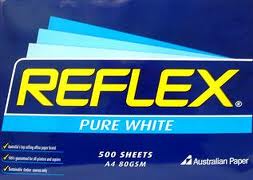
 Scott Gentle from the Victorian Forest Contractors Association
questions the logic of the Yarra Ranges council’s decision to boycott Reflex paper products.
[Source: ^http://free-press-leader.whereilive.com.au/news/story/paper-ban-anger/]
Scott Gentle from the Victorian Forest Contractors Association
questions the logic of the Yarra Ranges council’s decision to boycott Reflex paper products.
[Source: ^http://free-press-leader.whereilive.com.au/news/story/paper-ban-anger/]
.
.
Further Reading:
.
[1] ‘Brown Mountain Rape’, ^http://candobetter.net/node/1005
[2] Ethical Paper, ^http://www.ethicalpaper.com.au/
[3] Save Sylvia Creek Toolangi, ^http://www.myenvironment.net.au/index.php/me/Community/SAVE-Sylvia-Creek-Toolangi
[4] Brown Mountain – final court orders, ^http://www.eastgippsland.net.au/?q=campaigns/brown_mountain/whats_new
[5] Reflex Office Paper, ^http://www.greenwashreport.org/node/41
[6] Victorian Supreme Court Decision: ‘Environment East Gippsland Inc v VicForests [2010] VSC 335 (11 August 2010)’, ^http://www.austlii.edu.au/au/cases/vic/VSC/2010/335.html
.
.
– end of article –
